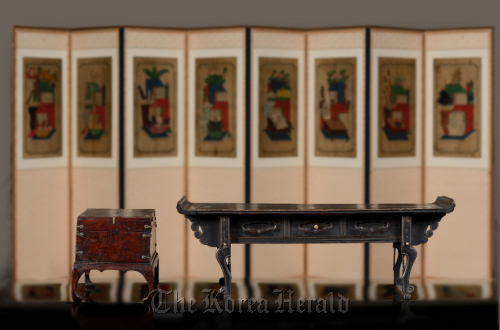National Folk Museum exhibition features wooden furniture from Joseon period
Renowned artist Kim Hwan-ki was known for his attachment to Korea’s traditional wooden furniture.
An avid collector of the wooden pieces, he often used them as the subjects of his famous paintings. A 1956 piece features simple wooden shelves filled with white porcelain jars of different shapes.
A special exhibition hosted by the National Folk Museum of Korea introduces the world of Joseon wooden furniture and its distinctive charm that inspired many like Kim.
The show, titled “Korean Furniture: Sensitivity and Lines,” features some 60 pieces of wooden furniture, most of them from the Joseon Dynasty (1392-1897). All of the pieces ― ranging from a simple desk to a chest of drawers ― are from the collection of the museum.
“We purchased most of the pieces featured in this exhibition after 2004,” said curator Kim Hee-soo.
“The pieces were used by ‘yangban,’ or the literati, during the Joseon period.”
The exhibition is divided into four parts. The first part showcases a recreation of a Joseon household in a traditional hanok, from its “sarangbang,” the reception room, to “anbang,” the main room, to the kitchen.
 |
The inside view of a “sarangbang,” a reception room of a Joseon aristocratic house. (The National Folk Museum of Korea) |
Sarangbang, a room where the male head of the household would stay and receive his guests and fellow scholars, was a place of exchange of views on various matters, including art, politics and literature.
The exhibition showcases a “standard” sarangbang, which is filled with stationery-related furniture ― including a desk, book shelves, and a chest of drawers for stationery. One can also see here three pieces of “byeoru,” Korea’s traditional inkstone, created by inkstone-maker and intangible cultural heritage title holder Kim Jin-han and his father and grandfather ― who all devoted their lives to byeoru-making.
Almost all of the sarangbang furniture is strikingly simple in its lines and design. The pieces reflect the Confucian values and teachings that influenced every aspect of Joseon’s aristocrat “seonbi” life ― which emphasized integrity and frugality.
 |
A two-tier wardrobe |
In the recreation of the anbang, the main room, one will find a Joseon woman’s dressing table, as well as a number of hair ornaments they used every day.
The second part of the exhibition explores how the wooden furniture was actually used in the everyday lives of Joseon people. Using artist Kim Hwan-ki’s painting of the wooden shelves and white porcelain jars as an example, the exhibition shows how the pieces created a great harmonious beauty when they were placed with Joseon’s everyday objects, such as plates, jars, and “bojagi,” Korea’s traditional textile work.
The third part of the exhibition features Korea’s intangible cultural heritage title holder and carpenter Park Myung-bae, and his way of making traditional chests of drawers. Watching a number of video clips, one can see how Park trims the wood from a pine tree, the complicated process of making the chest of drawers, as well as various tools that he uses.
Stepping into the fourth part of the exhibition, one can experience how the traditional furniture and their styles still influence the carpenters and designers today. This section features the works of contemporary furniture designer Ha Ji-hoon, who is known for his distinctive use of traditional techniques mixed with modernistic touches.
“The purpose of this exhibition, after all, is to show how the traditional furniture still lives on,” said curator Kim.
The exhibition runs until July 2 at the National Folk Museum of Korea in central Seoul. For more information, call (02) 3704-3173 or visit www.nfm.go.kr.
By Claire Lee (
dyc@heraldcorp.com)







![[Herald Interview] 'Trump will use tariffs as first line of defense for American manufacturing'](http://res.heraldm.com/phpwas/restmb_idxmake.php?idx=644&simg=/content/image/2024/11/26/20241126050017_0.jpg)
![[Exclusive] Hyundai Mobis eyes closer ties with BYD](http://res.heraldm.com/phpwas/restmb_idxmake.php?idx=644&simg=/content/image/2024/11/25/20241125050044_0.jpg)
